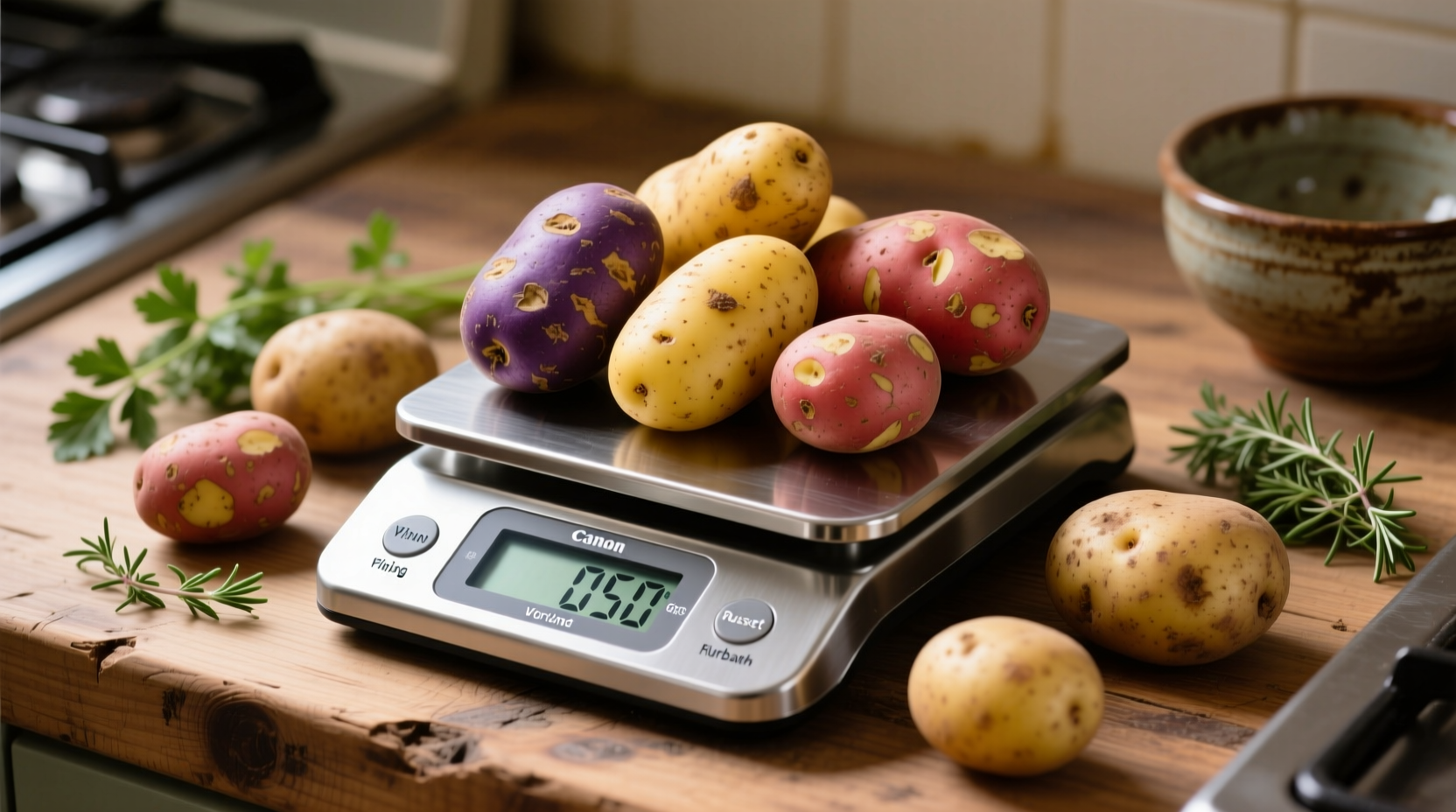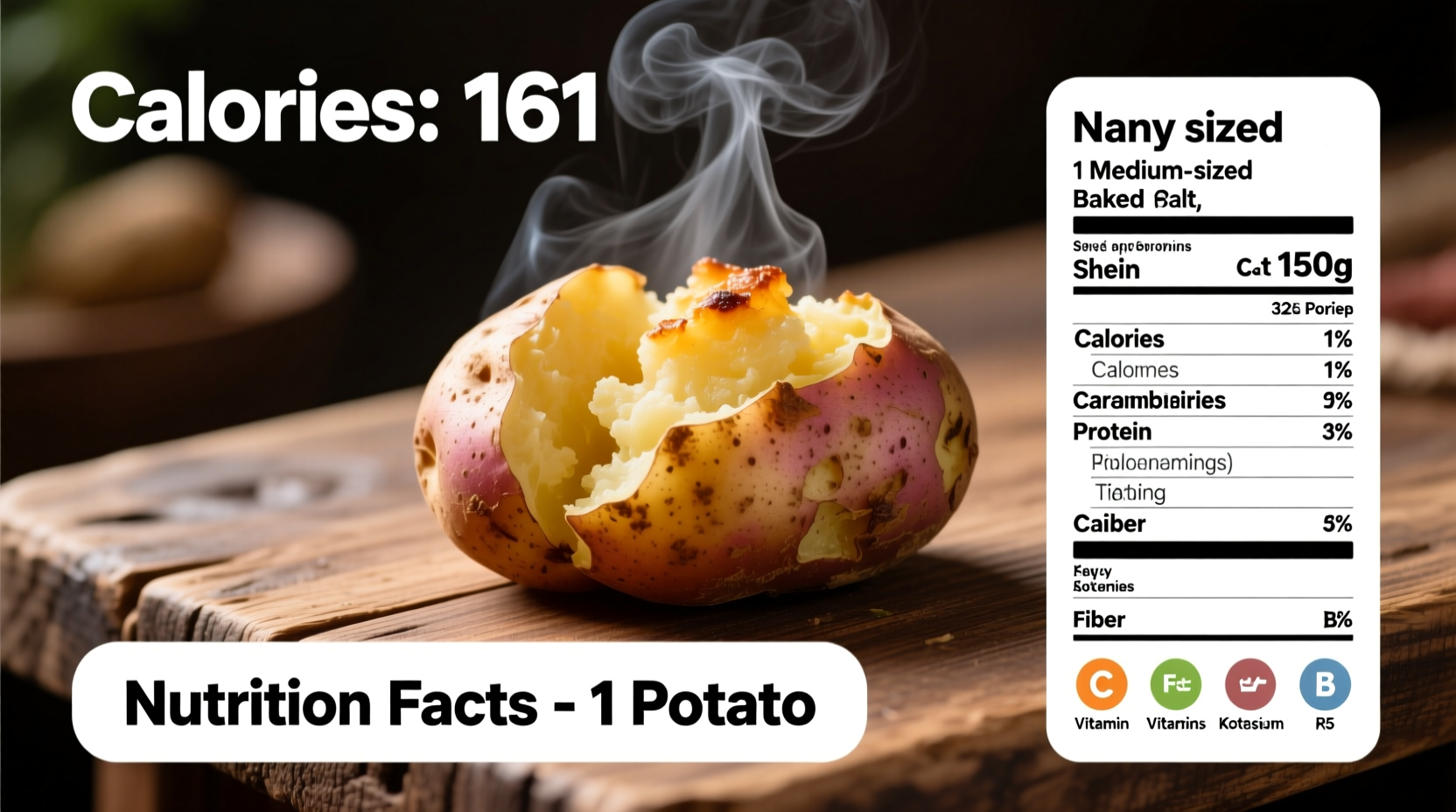Understanding the exact calorie content of potatoes is essential for anyone tracking their nutrition, whether for weight management, diabetes control, or general health awareness. Potatoes often get misunderstood in dietary discussions, but when properly measured, they can be a valuable part of balanced eating.
Why Potato Calorie Counts Vary
Not all potatoes are created equal when it comes to calories. The nutritional profile changes based on several key factors:
- Potato variety - Russet, red, yellow, and sweet potatoes each have different compositions
- Size and weight - A small new potato versus a large baking potato differs dramatically
- Preparation method - Raw, boiled, baked, or fried changes the calorie density
- Skin inclusion - Keeping the skin adds fiber but minimal calories

Potato Calorie Comparison by Type
Based on USDA FoodData Central measurements, here's how common potato varieties compare when measured by standard serving sizes:
| Potato Type | Standard Serving | Calories | Carbohydrates | Fiber |
|---|---|---|---|---|
| Russet (Baking) | 5.3 oz (150g) raw | 110 | 26g | 2.1g |
| Red Potato | 5.3 oz (150g) raw | 100 | 23g | 2.0g |
| Sweet Potato | 5.3 oz (150g) raw | 135 | 31g | 3.6g |
| Fingerling | 5.3 oz (150g) raw | 105 | 24g | 2.2g |
| Yukon Gold | 5.3 oz (150g) raw | 105 | 24g | 2.0g |
This comparison comes directly from the USDA FoodData Central database, the official U.S. government source for food composition data. Note that these values represent raw potatoes before cooking.
How Cooking Methods Change Calorie Content
The way you prepare potatoes significantly impacts their final calorie count. Here's what happens during common cooking processes:
Water-Based Cooking (Boiling, Steaming)
When potatoes are boiled or steamed, they absorb water which slightly dilutes the calorie density per gram. A medium boiled potato (5.3 oz / 150g) contains about 100-110 calories—similar to raw but with slightly less concentrated carbohydrates due to water absorption.
Dry Heat Cooking (Baking, Roasting)
Baking causes water loss through evaporation, concentrating the calories in the remaining mass. A medium baked russet potato (5.3 oz / 150g raw becomes about 130g cooked) contains approximately 130 calories. The reduction in water content means slightly more calories per ounce compared to raw.
Fat-Based Cooking (Frying, Sautéing)
This is where calorie counts can skyrocket. The absorption of cooking oil dramatically increases calories:
- French fries (3 oz / 85g serving): 130-150 calories
- Hash browns (3 oz / 85g): 140 calories
- Deep-fried potato chips (1 oz / 28g): 155 calories
The difference comes from oil absorption—potatoes can soak up 10-20% of their weight in oil during frying, adding approximately 90 calories per tablespoon of oil absorbed.
Practical Measurement Tips for Accurate Tracking
Getting precise calorie counts requires proper measurement techniques:
- Use a kitchen scale - Visual estimation of potato size is notoriously inaccurate
- Measure before cooking - Raw weights provide the most consistent tracking baseline
- Account for added ingredients - Butter, oil, sour cream add significant calories
- Consider your potato variety - Not all "medium" potatoes are nutritionally equivalent
For meal planning, remember that a standard "serving" of potato in dietary guidelines is 1/2 cup cooked (about 70g), which contains approximately 60-70 calories depending on preparation. This smaller portion size often gets overlooked when people consider potatoes "high calorie."
Putting Potato Calories in Nutritional Context
While tracking calories matters, potatoes offer valuable nutrients beyond just energy content:
- Excellent source of vitamin C (especially when skin is eaten)
- Good potassium content (more than a banana by weight)
- Contains resistant starch when cooled after cooking, which benefits gut health
- Naturally fat-free and cholesterol-free
According to research published in the American Journal of Clinical Nutrition, potatoes can be part of successful weight management when prepared healthily and portion-controlled. The key is understanding that preparation method matters more than the potato itself.
Common Misconceptions About Potato Calories
Several myths persist about potato nutrition that deserve clarification:
- "Potatoes are just empty calories" - False. They provide vitamins, minerals, and fiber alongside carbohydrates
- "Sweet potatoes are always healthier" - Context dependent. Sweet potatoes have more vitamin A, but regular potatoes offer more potassium
- "All preparation methods yield similar calories" - Major differences exist between boiled, baked, and fried
- "The skin contains most calories" - The skin adds fiber but minimal calories (about 10% of total)
Smart Ways to Include Potatoes in Your Diet
For those monitoring calorie intake, these strategies help enjoy potatoes without excess calories:
- Choose boiling or baking over frying
- Keep the skin on for added fiber that increases satiety
- Let cooked potatoes cool before eating to increase resistant starch content
- Pair with protein and non-starchy vegetables for balanced meals
- Measure portions rather than eating "until full"
Registered dietitians often recommend including potatoes as part of a varied diet rather than eliminating them completely. The Harvard T.H. Chan School of Public Health notes that starchy vegetables like potatoes can be part of healthy eating patterns when prepared without added fats and sugars.
Frequently Asked Questions
How many calories in a medium baked potato without skin?
A medium baked potato (5.3 oz / 150g raw weight) without skin contains approximately 120 calories. Removing the skin reduces fiber content but only decreases calories by about 10-15 compared to eating with skin, as most calories come from the flesh.
Do potatoes have more calories when cooked?
Potatoes have slightly more calories per ounce when baked or roasted due to water loss during cooking, but the total calorie content for the entire potato remains similar to raw. Boiled potatoes have comparable calories to raw as they absorb water. Fried potatoes have significantly more calories due to oil absorption.
How many calories in a small red potato?
A small red potato (about 2 inches in diameter, 138g) contains approximately 100 calories. Red potatoes are slightly lower in calories than russets of the same weight, with about 100 calories per 5.3 oz (150g) serving.
Are sweet potatoes higher in calories than regular potatoes?
Yes, sweet potatoes contain slightly more calories than regular potatoes of the same weight. A 5.3 oz (150g) sweet potato has about 135 calories compared to 110 calories in a russet potato. However, sweet potatoes provide significantly more vitamin A and fiber.
How does cooling potatoes after cooking affect calories?
Cooling potatoes after cooking increases their resistant starch content, which your body doesn't fully digest. This means you absorb slightly fewer calories from cooled potatoes compared to when eaten hot. The difference is modest (about 5-10% fewer digestible calories), but it also provides gut health benefits.











 浙公网安备
33010002000092号
浙公网安备
33010002000092号 浙B2-20120091-4
浙B2-20120091-4